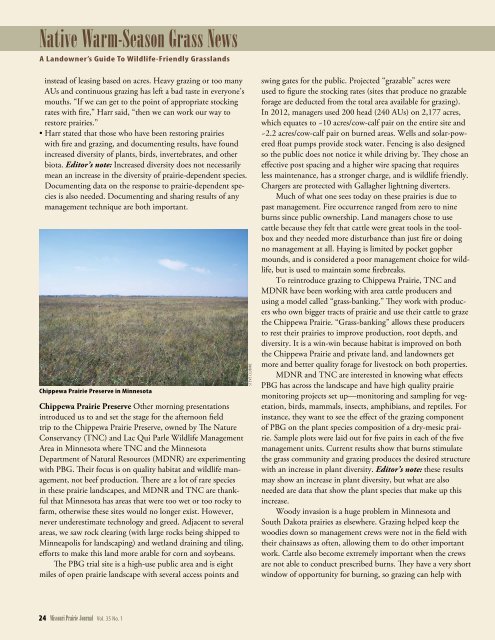l4c9lj6
l4c9lj6
l4c9lj6
You also want an ePaper? Increase the reach of your titles
YUMPU automatically turns print PDFs into web optimized ePapers that Google loves.
Native Warm-Season Grass News<br />
A Landowner’s Guide To Wildlife-Friendly Grasslands<br />
instead of leasing based on acres. Heavy grazing or too many<br />
AUs and continuous grazing has left a bad taste in everyone’s<br />
mouths. “If we can get to the point of appropriate stocking<br />
rates with fire,” Harr said, “then we can work our way to<br />
restore prairies.”<br />
• Harr stated that those who have been restoring prairies<br />
with fire and grazing, and documenting results, have found<br />
increased diversity of plants, birds, invertebrates, and other<br />
biota. Editor’s note: Increased diversity does not necessarily<br />
mean an increase in the diversity of prairie-dependent species.<br />
Documenting data on the response to prairie-dependent species<br />
is also needed. Documenting and sharing results of any<br />
management technique are both important.<br />
Chippewa Prairie Preserve in Minnesota<br />
Chippewa Prairie Preserve Other morning presentations<br />
introduced us to and set the stage for the afternoon field<br />
trip to the Chippewa Prairie Preserve, owned by The Nature<br />
Conservancy (TNC) and Lac Qui Parle Wildlife Management<br />
Area in Minnesota where TNC and the Minnesota<br />
Department of Natural Resources (MDNR) are experimenting<br />
with PBG. Their focus is on quality habitat and wildlife management,<br />
not beef production. There are a lot of rare species<br />
in these prairie landscapes, and MDNR and TNC are thankful<br />
that Minnesota has areas that were too wet or too rocky to<br />
farm, otherwise these sites would no longer exist. However,<br />
never underestimate technology and greed. Adjacent to several<br />
areas, we saw rock clearing (with large rocks being shipped to<br />
Minneapolis for landscaping) and wetland draining and tiling,<br />
efforts to make this land more arable for corn and soybeans.<br />
The PBG trial site is a high-use public area and is eight<br />
miles of open prairie landscape with several access points and<br />
Steve Clubine<br />
swing gates for the public. Projected “grazable” acres were<br />
used to figure the stocking rates (sites that produce no grazable<br />
forage are deducted from the total area available for grazing).<br />
In 2012, managers used 200 head (240 AUs) on 2,177 acres,<br />
which equates to ~10 acres/cow-calf pair on the entire site and<br />
~2.2 acres/cow-calf pair on burned areas. Wells and solar-powered<br />
float pumps provide stock water. Fencing is also designed<br />
so the public does not notice it while driving by. They chose an<br />
effective post spacing and a higher wire spacing that requires<br />
less maintenance, has a stronger charge, and is wildlife friendly.<br />
Chargers are protected with Gallagher lightning diverters.<br />
Much of what one sees today on these prairies is due to<br />
past management. Fire occurrence ranged from zero to nine<br />
burns since public ownership. Land managers chose to use<br />
cattle because they felt that cattle were great tools in the toolbox<br />
and they needed more disturbance than just fire or doing<br />
no management at all. Haying is limited by pocket gopher<br />
mounds, and is considered a poor management choice for wildlife,<br />
but is used to maintain some firebreaks.<br />
To reintroduce grazing to Chippewa Prairie, TNC and<br />
MDNR have been working with area cattle producers and<br />
using a model called “grass-banking.” They work with producers<br />
who own bigger tracts of prairie and use their cattle to graze<br />
the Chippewa Prairie. “Grass-banking” allows these producers<br />
to rest their prairies to improve production, root depth, and<br />
diversity. It is a win-win because habitat is improved on both<br />
the Chippewa Prairie and private land, and landowners get<br />
more and better quality forage for livestock on both properties.<br />
MDNR and TNC are interested in knowing what effects<br />
PBG has across the landscape and have high quality prairie<br />
monitoring projects set up—monitoring and sampling for vegetation,<br />
birds, mammals, insects, amphibians, and reptiles. For<br />
instance, they want to see the effect of the grazing component<br />
of PBG on the plant species composition of a dry-mesic prairie.<br />
Sample plots were laid out for five pairs in each of the five<br />
management units. Current results show that burns stimulate<br />
the grass community and grazing produces the desired structure<br />
with an increase in plant diversity. Editor’s note: these results<br />
may show an increase in plant diversity, but what are also<br />
needed are data that show the plant species that make up this<br />
increase.<br />
Woody invasion is a huge problem in Minnesota and<br />
South Dakota prairies as elsewhere. Grazing helped keep the<br />
woodies down so management crews were not in the field with<br />
their chainsaws as often, allowing them to do other important<br />
work. Cattle also become extremely important when the crews<br />
are not able to conduct prescribed burns. They have a very short<br />
window of opportunity for burning, so grazing can help with<br />
24 Missouri Prairie Journal Vol. 35 No. 1


